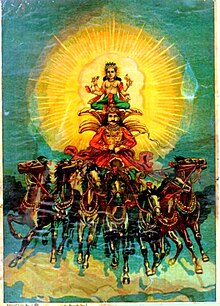
Ädityahá¹dayam ( Sanskrit: à¤à¤¦à¤¿à¤¤à¥à¤¯à¤¹à¥à¤¦à¤¯à¤®à¥, Sanskrit pronunciation: [aËdɪtjÉɦɽɪdÉjÉm]) is a Hindu devotional hymn, dedicated to Äditya or SÅ«rya (the Sun God), found in the Yuddha KÄnda (6.105) of VÄlmÄ«ki's RÄmÄyana. [1] It was recited by the sage Agastya to RÄma in the battlefield before fighting with the Rakshasa king RÄvaá¹a. In it, Agastya teaches RÄma the procedure of worshiping Äditya for strength to defeat the enemy. [2]
Etymology
Äditya ( Sanskrit: à¤à¤¦à¤¿à¤¤à¥à¤¯, lit. "son of Aditi") refers to the Sun. Há¹dayam ( Sanskrit: हà¥à¤¦à¤¯à¤®à¥) is the Sanskrit word for "heart".
Structure
The Ädityahá¹dayam is made up of thirty Åhlokas which can be divided into six sections:
| 1â2 | Agastya Rishi approaches RÄma. |
| 3â5 | Agastya Rishi states the greatness of the Ädityahá¹idayam and advantages of reciting it. |
| 6â15 | A description of Äditya as the embodiment of all gods as well as nourisher, sustainer, and giver of heat. |
| 16â20 | Mantra japa. |
| 21â24 | Salutations to Äditya. |
| 25â30 | A description of the results of this prayer, the method of recital, and the procedure followed by RÄma to successfully invoke Äditya to bless him with the requisite strength for the victory on the battlefield. |
See also
References
- ^ Ramayana, Book VI, CANTO CVI.: GLORY TO THE SUN. Sacred-texts.com
- ^ Gopal, Madan (1990). K.S. Gautam (ed.). India through the ages. Publication Division, Ministry of Information and Broadcasting, Government of India. p. 62.
External links

Ädityahá¹dayam ( Sanskrit: à¤à¤¦à¤¿à¤¤à¥à¤¯à¤¹à¥à¤¦à¤¯à¤®à¥, Sanskrit pronunciation: [aËdɪtjÉɦɽɪdÉjÉm]) is a Hindu devotional hymn, dedicated to Äditya or SÅ«rya (the Sun God), found in the Yuddha KÄnda (6.105) of VÄlmÄ«ki's RÄmÄyana. [1] It was recited by the sage Agastya to RÄma in the battlefield before fighting with the Rakshasa king RÄvaá¹a. In it, Agastya teaches RÄma the procedure of worshiping Äditya for strength to defeat the enemy. [2]
Etymology
Äditya ( Sanskrit: à¤à¤¦à¤¿à¤¤à¥à¤¯, lit. "son of Aditi") refers to the Sun. Há¹dayam ( Sanskrit: हà¥à¤¦à¤¯à¤®à¥) is the Sanskrit word for "heart".
Structure
The Ädityahá¹dayam is made up of thirty Åhlokas which can be divided into six sections:
| 1â2 | Agastya Rishi approaches RÄma. |
| 3â5 | Agastya Rishi states the greatness of the Ädityahá¹idayam and advantages of reciting it. |
| 6â15 | A description of Äditya as the embodiment of all gods as well as nourisher, sustainer, and giver of heat. |
| 16â20 | Mantra japa. |
| 21â24 | Salutations to Äditya. |
| 25â30 | A description of the results of this prayer, the method of recital, and the procedure followed by RÄma to successfully invoke Äditya to bless him with the requisite strength for the victory on the battlefield. |
See also
References
- ^ Ramayana, Book VI, CANTO CVI.: GLORY TO THE SUN. Sacred-texts.com
- ^ Gopal, Madan (1990). K.S. Gautam (ed.). India through the ages. Publication Division, Ministry of Information and Broadcasting, Government of India. p. 62.
